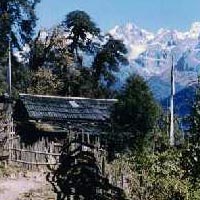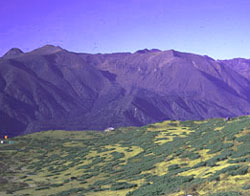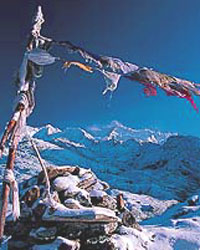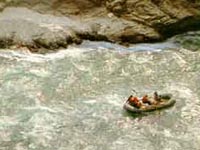| Destinations
|
|||
Frequently Asked Questions about Sikkim
Q1. How do I reach there? Answer: Ex- Calcutta there are two options. Either by flight to Bagdogra or by train to New Jalpaiguri. From there the capital, Gangtok, is 4 hrs away. Sikkim is well connected by rail and air to the rest of the country through Siliguri in West Bengal. There are no airports or railway stations in Sikkim. The primary means of transport within Sikkim is by road. To get to Sikkim you must first reach Siliguri.
a) By Air: The nearest airport is Bagdogra near Siliguri in West Bengal. It is connected by daily flights from New Delhi and 6 flights from Calcutta (excluding Thursdays) every week. It is 115 kms from Gangtok and takes about 4 1/2 hrs. Recently a 4-seater helicopter service from Bagdogra to Gangtok has started and takes about 20min. ~Indian Airlines~ b) By Rail: The broad guage railway station is New Jalpaiguri, near Siliguri. The Dadar Guwahati Express is the only direct train from Mumbai. From Calcutta, it is easily accessible by both rail and road. From Delhi, the New Delhi-Guwahati Rajdhani passes through New Jalpaiguri. (Please check railway schedules as they are apt to change) ~Indian Railways~ c) From nearby hill stations: If you are planning a visit to Darjeeling, Kalimpong, Mirik or Bhutan, you can combine the trip with extensions to Sikkim or vice versa. |
More about Sikkim • An Overview • Geography • History • People & Culture • Economy • Festivals • Off the Beaten Track • Wild Life • Adventure • Monastery Magic • Gangtok • Tourist Information • Accommodation • Getting There • Climate
Travelogues
Trekking | ||
Answer: In the capital Gangtok, there is a wide range of available options. But in other places: West Sikkim - Comfortable, neat, clean, with attached bathrooms but not luxurious. Excellent locations. North Sikkim - Basic, neat, clean, with attached bathroom. Excellent locations. In Gangtok, you would get top of the line hotels like Nork-hill and Tashi Delek. Good 3 stars like Chumbi Residency are also available. Medium budget hotels like Mt. Simvo in Tadong, away from the hustle and bustle of Gangtok are also there. In Rumtek, 24 kms from Gangtok, you could stay at Shambala Resort. At Martam village, 5 kms from Rumtek, you could stay at Martam Village Resort. At Aritar, a beautiful and quiet place in Rhenock, East Sikkim, 55 kms from Gangtok, one can stay at The Aritar Retreat. In West Sikkim, the hotels are comfortable but not luxurious. Yuksom, Hotel, Tashigang is a good place for relaxing for a few days. Similar hotels are there in Pelling, a moderately crowded town with stupendous views of the Khangchendzonga range. In North Sikkim, the accommodation is very basic but comfortable log huts at Lachung, Lachen and Yakchey. It's a great experience to spend a couple of nights in them. There are rooms available with attached toilet, electricity, room heaters, hot water facilities and blankets. Q3. What kind of food is available? Answer: Veg as well as non-veg is easily available in the more accessible regions of Sikkim. Indian, Tibetan and Chinese cuisine, and a limited range of continental cuisine is available. In North Sikkim veg as well as non-veg is available but there is a very limited choice of dishes because it is a very remote place. Sikkim offers a variety of local fare. The momo and the thukpa are great to eat. In Gangtok, there are several good veg and non-veg restaurants. Fast food is also available at Cafe Tibet. In North Sikkim at Lachung, Yumthang and Lachen, it's difficult to get decent food as the eating houses here are for local people only. In Yuksom, Hotel Tashigang is the safest bet. In Pelling, you will get good food in Hotel Sikkim Tourist Centre and Hotel Norbugang. For drinking water, you are advised to use bottled mineral water, or treated water only. Q4. What are the available modes of transport and what is the condition of the roads? Answer: Within Sikkim jeeps are the most popular form of transport. Most jeeps are Mahindra Commander 4 wheel drive, but there are also a limited number of Sumos. In certain areas, Maruti vans are also used. From New Jalpaiguri/ Bagdogra to Darjeeling or Gangtok, 28 seater mini buses also ply. Individual (private) jeeps have a maximum capacity of 10 persons whereas vans take 4 persons. In North Sikkim only shared jeeps are available with the maximum no of persons being 7. Among all the hill stations and tourist places in the Himalayas, Sikkim has the best roads. Roads are maintained by the Indian Army. Q5. Which places should one visit in Sikkim?
Q6. Is it close to Assam? Answer: No, Assam is 900 kms away. Q7. As a border state, how safe is it? Answer: It is the safest state in India. Lowest crime rate. Terrorism: Nil. Q8. Are their any entry restrictions or permissions needed? Answer: Indians only need permits to enter the restricted areas or the inner line permit areas. Indians travelling in Sikkim would be advised to carry either passport, drivers license or election voting card or ration card. It is generally not required, because Indians do not need permits to enter Sikkim. But identification documents proving your Indian identity may be needed. An NRI holding a valid Indian passport is also allowed. Foreigners need a permit to enter Sikkim. Indians with foreign passport also need permits. Q9. What are the entry restrictions?
a) North Sikkim: Chungthang, Lachung, Yumthang Valley, Yumesamdong, Lachen, Thangu, Chopta and Gurudongmar Lake. b) East Sikkim: Tsongo Lake, Nathula Pass, Kupup and Menmecho Lake. The ILP can be obtained from Sikkim Police, Gangtok. Any reputed travel agent will also organise the same for you. For Nathula Pass, Kupup and Menmecho Lake, small groups are now permitted to visit these areas with special permits from the Army. Foreign nationals would require a restricted area permit to visit areas that are unrestricted for Indian Nationals. Foreign Nationals are permitted to visit Gangtok, Rumtek, Phodong and Pemayangtse on the basis of a 15 day visa. A special endorsement allows access to areas around Pemayangste. A 15 day visa-extension is available in Gangtok from the Home Office, Tashiling Secretariat. Foreigners are allowed a day visit to Tsongo lake provided they are in groups of four or more. They are also permitted to trek to the Dzongri area and to Yumthang valley and Lachen provided they are in a group of four or more and are doing the trek through a recognized travel agency. Permits can be obtained from the Foreigners Regional Registration Offices at Delhi, Mumbai, Calcutta and Darjeeling as well as from the Sikkim Tourism Information Centre in Calcutta and Siliguri. Q 10 . What are the telecom facilities? Answer: You can dial STD from Gangtok and even Pelling and Yuksom which are about 150 kms from Siliguri/ NJP. Only from North Sikkim phones are not readily available. Q 11. What are the languages spoken? Answer: You can communicate in English & Hindi. Q12. What is the best time to visit Sikkim? Does it snow in Sikkim? Answer: There are 3 seasons for visiting Sikkim.
a) Summer: Summer is from mid-April till the end of May after which the monsoons break at the beginning of June. This is the time when the rhododendrons are in full bloom in places like Yumthang, Varshey (West Sikkim-2 day trek) etc. The skies are fairly clear with occasional showers. This is one of the best times to go on treks. b) Autumn: This is a great season when the skies are clear and the mountains are preparing for the winter months ahead. The snow clad peaks should now be visible with the air at its cleanest after 4 months of torrential rains.
Note: Avoid visiting Sikkim from mid-June to 10th September due to heavy rains and occasional landslides. However, the high rates of discounts offered by hotels and the sparse crowd in the monsoons are incentive enough for the intrepid traveler. Q 13. What about landslides? Answer: Sikkim is a landslide prone area and in the monsoons many parts of Sikkim are cut off. The repairs are taken care of by the Border Roads Organisation (BRO), who do a great job of clearing the roads as fast as possible. With the border close by, it is also imperative from the defence point of view to keep the roads as clear as possible. `Transshipments' across landslides are common and can be an adventurous experience! Q 14.What shopping can I do there? Answer: First and foremost are the handicrafts. Reliable shops are the Govt. Institute of Cottage Industry in Gangtok or the Dalai Lama Trust Fund shop in the basement of Hotel Tibet. These are also available in other shops, but browse around for an idea of prices. You can check out the canvas wall hangings, thankas, prayer wheels, Tibetan carpets, rugs and jewellery, particularly the exquisitely carved dragon sets in silver and gold inlaid with precious stones, which are unique to Sikkim. Sikkim tea and cardamom are other good buys. Q15. What about adventure sports?
Some popular trekking routes:
a) Tashi view point to Tinjure trek: ex- Gangtok.1 day. Compiled by Romola Butalia
|
|||
Editor: Romola Butalia (c) India Travelogue. All rights reserved. |
|||
 Q2. What kind of accommodation is available?
Q2. What kind of accommodation is available?
 Answer: Most people do a tour of the golden triangle comprising Darjeeling and Kalimpong in nearby West Bengal and Gangtok, the capital of Sikkim. They complete this trip in about a week's time ex-New Jalpaiguri (the nearest railway station) or Bagdogra (the nearest airport). But Gangtok is barely an entry into Sikkim! There's so much more to Sikkim than merely Gangtok. With more time and an adventurous spirit, both West Sikkim and North Sikkim are a treat to visit.
Answer: Most people do a tour of the golden triangle comprising Darjeeling and Kalimpong in nearby West Bengal and Gangtok, the capital of Sikkim. They complete this trip in about a week's time ex-New Jalpaiguri (the nearest railway station) or Bagdogra (the nearest airport). But Gangtok is barely an entry into Sikkim! There's so much more to Sikkim than merely Gangtok. With more time and an adventurous spirit, both West Sikkim and North Sikkim are a treat to visit.
 Answer : For the following restricted areas Indians need Inner Line Permits (ILP):
Answer : For the following restricted areas Indians need Inner Line Permits (ILP):
 c) Winters: This is the season for those who dare. A visit to Yumthang Valley in winters offers an awesome panorama of a wilderness under a sheet of snow. Tsongo Lake is frozen solid and remains that way till Feb-March. Even in early April one can frolic in the ice in Yumthang and Tsongo, although it doesn't normally snow there in April. But be warned, it's really cold out there!
c) Winters: This is the season for those who dare. A visit to Yumthang Valley in winters offers an awesome panorama of a wilderness under a sheet of snow. Tsongo Lake is frozen solid and remains that way till Feb-March. Even in early April one can frolic in the ice in Yumthang and Tsongo, although it doesn't normally snow there in April. But be warned, it's really cold out there!
 Answer: For the outdoor buff, Sikkim offers a wide circuit of trekking routes. River rafting on the Teesta and the Rangit rivers is also an option. Recently, helicopter flights to Mt. Khangchendzonga have also been started from Gangtok.
Answer: For the outdoor buff, Sikkim offers a wide circuit of trekking routes. River rafting on the Teesta and the Rangit rivers is also an option. Recently, helicopter flights to Mt. Khangchendzonga have also been started from Gangtok.